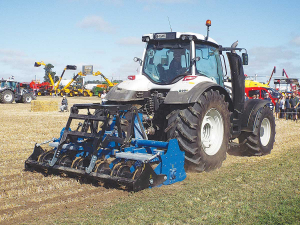Strip-till offers major savings
The Fookes family farm at Korakonui, just south-east of Te Awamutu in the Waikato.
 Tulloch Farm Machines offers the Strebel SAG 16 Strip Tillage System for establishing maize and fodder beet crops.
Tulloch Farm Machines offers the Strebel SAG 16 Strip Tillage System for establishing maize and fodder beet crops.
With farmers and contractors looking to reduce crop establishment costs, the arrival of increasingly accurate GPS and a range of specialised implements, may make 'recreational' cultivation a thing of the past.
Experts suggest that excessive cultivation is damaging soil structure, often bringing poor sub-soils up into the growing levels.
There is also the impact caused by loss of moisture and fine soils to the wind. Add to that the cost of our cultivator metal and high fuel costs, then new techniques are sure to be adopted in the coming years?
Strip Tilling is a technique that allows minimal soil disturbance, reducing cultivation costs by only cultivating a narrow band of soil where the crop is going to be established. It leaves the ground between rows unmoved and brings land back into production much more quickly.
Masterton-based importer and distributor Tulloch Farm Machines offers the Strebel SAG 16 Strip Tillage System, aimed at establishing maize and fodder beet crops throughout New Zealand.
The machine that takes the outward form of a rotary cultivator, but underneath, the traditional rotor is replaced by a unit that carries a series of "milling units" that only cultivate a band of ground where the crop is to be established.
With an overall width of 3m, the machine can be configured to prepare four rows at 75cm or six rows at 50cm spacing. Ahead of each of the rows is a subsoiler leg that can operate at depths of up to 25cm. This breaks up any plough pan, before passing soil to the rotor, which can operate to 15cm working depth for breaking down into a finer seedbed.
Rear of the milling heads, an infinitely adjustable packer system sees sectional units behind each of the four or six rotors. These reconsolidate the ground, leaving a level surface for subsequent operations. The lateral extremities of the main rotor housing feature extended side panels to create a definitive edge for the worked strips.
Manufactured using Hardox steel for durability and an extended working life, power input is 1,000rpm. It has a cam-clutch overload protection set-up, with a 4-speed main gearbox and gear-driven, lateral oil bath drive to the main rotor. Speed adjustment via the main gearbox allows operators to quickly adjust rotor speeds to ground conditions or required forward speed.
As an option, a Cat2/3 rear three-point linkage can be used to carry a precision planted. Or the installation of a front-mounted hopper can be specified to incorporate fertiliser into the prepared tillage strip ahead of the rotor.
The Coalition Government will need the support of at least one opposition party to ratify the free trade deal with India.
Primary sector leaders have welcomed the announcement of a Free Trade Agreement between India and New Zealand.
At Pāmu’s Kepler Farm in Manapouri, mating has wrapped up at the across-breed Beef Progeny Test.
More than 150 people turned up at Parliament recently to celebrate the 20th anniversary of Horticulture New Zealand (HortNZ).
Biosecurity New Zealand says Kiwis should continue to keep an eye out for yellow-legged hornets (Vespa velutina) over the holiday season.
Fonterra has slashed another 50c off its milk price forecast as global milk flows shows no sign of easing.

OPINION: The release of the Natural Environment Bill and Planning Bill to replace the Resource Management Act is a red-letter day…
OPINION: Federated Farmers has launched a new campaign, swapping ‘The Twelve Days of Christmas’ for ‘The Twelve Pests of Christmas’ to…